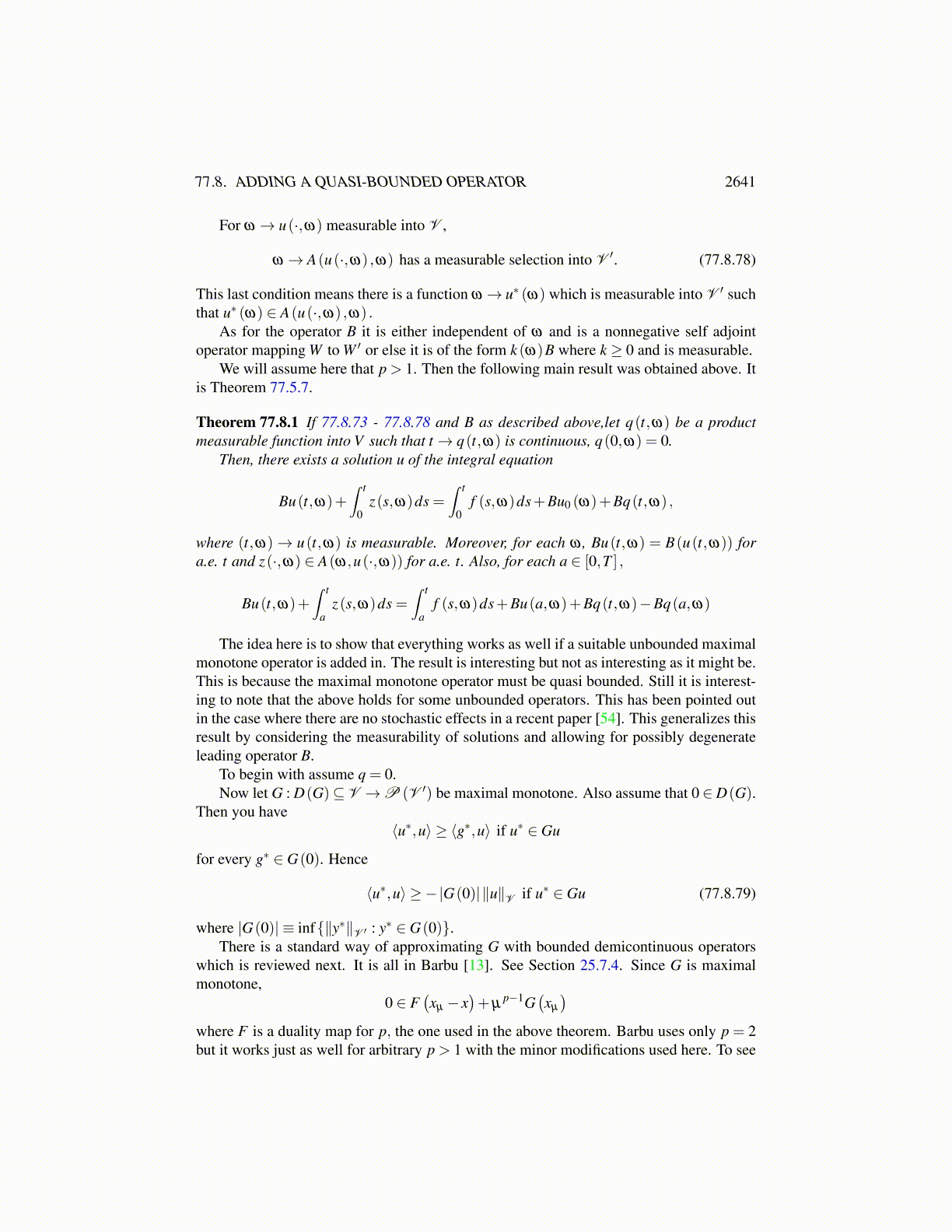
77.7. PROGRESSIVELY MEASURABLE SOLUTIONS 2641
Also let t→ q(t,ω) be continuous and q is progressively measurable into V. Suppose thereis at most one solution to
Bu(t,ω)+∫ t
0z(s,ω)ds =
∫ t
0f (s,ω)ds+Bu0 (ω)+Bq(t,ω) , (77.7.72)
for each ω . Then the solution u to the above integral equation is progressively measur-able and so is z. Moreover, for each ω , both Bu(t,ω) = B(u(t,ω)) a.e. t and z(·,ω) ∈A(u(·,ω) ,ω). Also, for each a ∈ [0,T ] ,
Bu(t,ω)+∫ t
az(s,ω)ds =
∫ t
af (s,ω)ds+Bu(a,ω)+Bq(t,ω)−Bq(a,ω)
Proof: By Theorem 77.5.7 there exists a solution to 77.7.72 which is B ([0,T ])×FTmeasurable. Now, as in the proof of Theorem 77.5.7 one can define a new operator
Ar (w,ω)≡ A(ω,w+qτr (·,ω))
where τr is the stopping time defined there. Then, since q is progressively measurable, theprogressively measurable condition is satisfied for this new operator. Hence by Theorem77.7.3 there exists a unique solution wr which is progressively measurable to the integralequation
Bwr (t,ω)+∫ t
0zr (s,ω)ds =
∫ t
0f (s,ω)ds+Bu0 (ω)
where zr (·,ω) ∈ Ar (w(·,ω) ,ω). Then as in Theorem 77.7.3 you can let r→ ∞ and even-tually qτr (·,ω) = q(·,ω). Then, passing to a limit, it follows that for a given ω, there is asolution to
Bw(t,ω)+∫ t
0z(s,ω)ds =
∫ t
0f (s,ω)ds+Bu0 (ω)
z(·,ω) ∈ A(w(·,ω)+q(·,ω) ,ω)
which is progressively measurable because w(·,ω) = limr→∞ wr (·,ω) in V each wr beingprogressively measurable. Note how uniqueness for fixed ω is important in this argument.Recall that
τr ≡ inf{t : |q(t,ω)|> r}
By continuity, eventually, for a given ω,τr = ∞ and so no further change takes place inqτr (·,ω) for that ω. By uniqueness, the same is true of the solution wr (·,ω) and so point-wise convergence takes place for the wr. Without uniqueness holding, this becomes veryunclear. Thus for each T̂ < T,ω → w(·,ω) is measurable into V[0,T̂ ]. Then by Lemma77.4.2, w has a representative in V for each ω such that the resulting function satisfies(t,ω)→X[0,T̂ ] (t)w(t,ω) is B
([0, T̂])×FT̂ measurable into V . Thus one can assume
that w is progressively measurable. Now as in Theorem 77.5.7, Define u = w+q.The last claim follows from letting t = a in the top equation and then subtracting this
from the top equation with t > a.